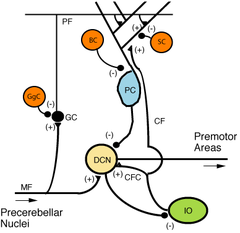- Climbing fiber
-
Neuron: Climbing fiber 
Microcircuitry of the cerebellum. Excitatory synapses are denoted by (+) and inhibitory synapses by (-). Climbing fiber is shown originating from the inferior olive (green).Location Inferior Olive and Cerebellum Function Unique excitatory function (see text) Morphology Unique projection neuron (see text) Presynaptic connections Inferior olive Postsynaptic connections Purkinje cells Gray's subject #187 796 Climbing fibers are the name given to a series of neuronal projections from the inferior olivary nucleus located in the medulla oblongata.[1][2]
These axons pass through the pons and enter the cerebellum via the inferior cerebellar peduncle where they form synapses with the deep cerebellar nuclei and Purkinje cells. Each climbing fiber will form synapses with 1-10 Purkinje cells.
Early in development, Purkinje cells are innervated by multiple climbing fibers, but as the cerebellum matures, these inputs gradually become eliminated resulting in a single climbing fiber input per Purkinje cell.
These fibers provide very powerful, excitatory input to the cerebellum which results in the generation of complex spike excitatory postsynaptic potential (EPSP) in Purkinje cells.[1] In this way climbing fibers (CFs) perform a central role in motor behaviors.[3]
Climbing fiber activation is thought to serve as a motor error signal sent to the cerebellum, and is an important signal for motor timing.
These climbing fibers carry information from various sources such as the spinal cord, vestibular system, red nucleus, superior colliculus, reticular formation and sensory and motor cortices.
Although in the central nervous system, these fibers are able to undergo to remarkable regenerative modifications in response to injuries, being able to generate new branches by sprouting to innervate surrounding Purkinje cells if these lose their CF innervation. [4] This kind of injury-induced sprouting has been shown to need the growth associated protein GAP-43.[5]
See also
- Axon terminals
- Parallel fiber
References
- ^ a b Harting, John K.; Helmrick, Kevin J. (1996,1997). "Cerebellum - Circuitry - Climbing Fibers". http://www.neuroanatomy.wisc.edu/cere/text/P4/climb.htm. Retrieved 2008-12-25.
- ^ Bear, Mark F.; Michael A. Paradiso; Barry W. Connors (2006) (Digitised online by Google Books). Neuroscience: Exploring the Brain. Lippincott Williams & Wilkins. p. 773. ISBN 0781760038, 9780781760034. http://books.google.com/?id=75NgwLzueikC&printsec=frontcover&dq=neuroscience+exploring+the+brain. Retrieved 2008-12-25. Image of Parallel fiber
- ^ McKay, Bruce E.; Engbers, Jordan D. T., W. Hamish Mehaffey, Grant R. J. Gordon, Michael L. Molineux, Jaideep S. Bains, and Ray W. Turner; Mehaffey, WH; Gordon, GR; Molineux, ML; Bains, JS; Turner, RW (January 31, 2007). "Climbing Fiber Discharge Regulates Cerebellar Functions by Controlling the Intrinsic Characteristics of Purkinje Cell Output". Journal of neurophysiology (J Neurophysiol) 97 (4): 2590–604. doi:10.1152/jn.00627.2006. PMID 17267759. http://www.ucalgary.ca/~rwturner/files/purkinje_trimodal_cf_07.pdf. Retrieved 2008-12-25.
- ^ Carulli D, Buffo A, Strata P (April 2004). "Reparative mechanisms in the cerebellar cortex". Prog Neurobiol 72 (6): 373–98. doi:10.1016/j.pneurobio.2004.03.007. PMID 15177783. http://www.sciencedirect.com/science/article/pii/S0301008204000413.
- ^ Grasselli G, Mandolesi G, Strata P, Cesare P (June 2011). "Impaired Sprouting and Axonal Atrophy in Cerebellar Climbing Fibres following In Vivo Silencing of the Growth-Associated Protein GAP-43". PLoS ONE 6 (6): e20791. doi:10.1371/journal.pone.0020791. http://www.plosone.org/article/info:doi/10.1371/journal.pone.0020791.
External links
- Climbing Fiber Discharge Regulates Cerebellar Functions by Controlling the intrinsic Characteristics of Purkinje Cell Output
- Spatiotemporal Tuning of Optic Flow Inputs to the Vestibulocerebellum in Pigeons: Differences Between Mossy and Climbing Fiber Pathways
Human brain, rhombencephalon, metencephalon: cerebellum (TA 14.1.07, GA 9.788) Surface anatomy LobesMedial/lateralVermis: anterior (Central lobule, Culmen, Lingula) · posterior (Folium, Tuber, Uvula) · Vallecula of cerebellum
Hemisphere: anterior (Alar central lobule) · posterior (Biventer lobule, Cerebellar tonsil)Grey matter Molecular layer (Stellate cell, Basket cell)
Purkinje cell layer (Purkinje cell, Bergmann glia cell = Golgi epithelial cell)
Granule cell layer (Golgi cell, Granule cell, Unipolar brush cell)
Fibers: Mossy fibers · Climbing fiber · Parallel fiberWhite matter InternalPedunclesInferior (medulla): Dorsal spinocerebellar tract · Olivocerebellar tract · Cuneocerebellar tract · Juxtarestiform body (Vestibulocerebellar tract)
Middle (pons): Pontocerebellar fibers
Superior (midbrain): Ventral spinocerebellar tract · Dentatothalamic tract · Trigeminocerebellar fibersCategories:- Central nervous system
- Cerebellum
- Brainstem
Wikimedia Foundation. 2010.
